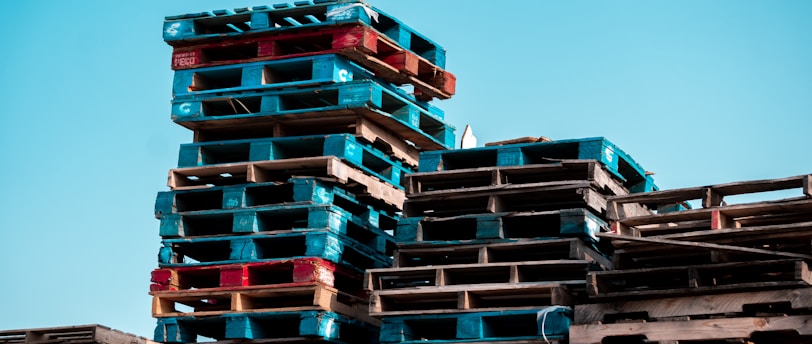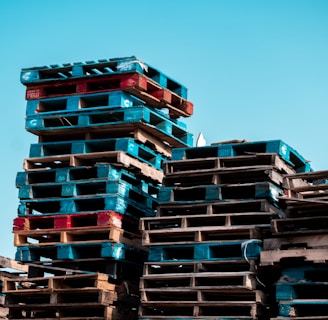
Introduction to the Concept of the Pallet
Diego Cuadrado
1/15/2024


The Historical Evolution of Pallets in Freight Transport
The story of pallets in freight transport is a saga of innovation, adaptation, and resilience. From their humble beginnings as rudimentary storage platforms, pallets have ascended to become a cornerstone of global logistics.
Early 20th Century Origins: The genesis of pallets can be traced back to the early 1900s. Initially, they were simple wooden skids, used primarily for storing goods. Their design was basic, and their use was not widespread. The real potential of pallets was yet to be realized.
World War II - A Catalyst for Change: The outbreak of World War II marked a turning point in the history of pallets. The war necessitated efficient methods for transporting a massive amount of supplies. Pallets, with their ability to be easily lifted by forklifts, emerged as a solution. This era saw rapid advancements in pallet design, including the introduction of the bottom deck, allowing for more stable and efficient handling of goods. The military’s adoption of pallets as a key component in logistics marked the beginning of their widespread use.
Post-War Expansion and Standardization: After the war, the commercial sector began to see the benefits of using pallets. The 1950s and 60s witnessed a boom in pallet usage, with industries worldwide adopting them to streamline their operations. This period also saw efforts towards standardization of pallet sizes, a move that would later facilitate international trade and logistics.
Technological Advancements: The latter half of the 20th century and the early 21st century have seen pallets evolve in tandem with technological advancements in logistics. From being mere wooden platforms, pallets have transformed into sophisticated tools equipped with RFID tags and IoT capabilities, enabling better tracking and management of goods.
Adapting to a Changing World: In recent times, pallets have had to adapt to the challenges posed by globalization and environmental concerns. This has led to the development of lighter, more durable, and sustainable pallet materials, ensuring that pallets continue to be relevant and effective in the modern logistics landscape.
As we explore the journey of pallets, their evolution from rudimentary wooden skids to sophisticated logistic tools mirrors the dynamic nature of the freight transport industry. OptiVlak, with its innovative approach, aligns perfectly with this evolution, leveraging the efficiency and standardization of pallets to optimize freight transport across Europe.
Material Innovations in Pallet Design
Wood - The Traditional Choice: Wood has been the primary material for pallets since their inception. Its advantages are evident - it's cost-effective, readily available, and easy to repair. Wooden pallets are versatile, making them suitable for a wide range of goods. However, they have limitations, such as susceptibility to moisture, pests, and a heavier weight compared to alternatives.
Rise of Plastic Pallets: Plastic pallets, made from high-density polyethylene (HDPE) or polypropylene (PP), have gained popularity due to their durability and weather resistance. They are lighter than wooden pallets, easier to clean, and more consistent in size and shape. Ideal for international shipping, plastic pallets are immune to pests and exempt from ISPM 15 regulations (international standards for phytosanitary measures). Their downside is a higher upfront cost and environmental concerns related to their production and disposal.
Metal Pallets - Durability and Strength: Metal pallets, typically made of steel or aluminum, are the strongest and most durable option. They are ideal for heavy or high-value goods and are commonly used in industries where sanitation is crucial, like pharmaceuticals or food. Their longevity is unparalleled, but so is their cost - both in terms of initial investment and shipping (due to their weight).
Innovative Materials: The drive for sustainability has led to the exploration of alternative materials like recycled plastics, composites, and even biodegradable options. These innovative materials aim to balance the need for durability and functionality with environmental responsibility.
In the food and beverage industry, plastic pallets are favored for their hygiene and ease of cleaning. For export purposes, companies are increasingly opting for lightweight, pest-resistant plastic pallets to comply with international shipping regulations. In heavy industries, metal pallets are preferred for their strength and longevity.
The Impact of Pallet Standardization
The standardization of pallets marks a significant milestone in the history of logistics, fundamentally transforming the efficiency of global supply chains.
Before standardization, the lack of uniform pallet sizes created inefficiencies in storage and transportation. Diverse pallet dimensions led to compatibility issues, complicating the loading and unloading process, and reducing the overall efficiency of goods movement.
The International Organization for Standardization (ISO) played a critical role in the standardization of pallet dimensions. This harmonization was essential for facilitating smoother international trade. Standardized pallets meant that goods could be more easily transported, stored, and handled across different countries and modes of transport.
The uniformity in pallet sizes brought about numerous advantages:
Improved warehouse storage efficiency, allowing for better space utilization.
Enhanced compatibility with different transportation modes, such as trucks, ships, and trains.
Reduced costs and time in the handling of goods.
Increased safety in the transport and storage of goods.
Standardization has been widely accepted globally, with many countries adopting ISO standards for pallets. This has led to a more interconnected and efficient global supply chain.
OptiVlak's Role in Modern Freight Transport Using Pallets
OptiVlak, in the realm of modern freight transport, stands out as a beacon of innovation, particularly in its use of pallets. The platform's approach to integrating pallet standardization and advancements is a testament to its commitment to efficiency and sustainability.
OptiVlak harnesses the potential of standardized pallets to streamline the freight forwarding process. By aligning its operations with universally accepted pallet dimensions, OptiVlak ensures seamless compatibility across different transport modes and international borders. This synchronization significantly reduces logistical challenges and enhances the efficiency of the shipping process.
Understanding that different industries have varying needs, OptiVlak offers tailored solutions. Whether it's a heavy-duty metal pallet for industrial goods or a lightweight plastic pallet for perishable items, OptiVlak's platform can match the specific requirements of each shipment with the most suitable pallet type.
OptiVlak's platform is not just about physical logistics; it's also about technological integration. The use of RFID tags and IoT technology in pallets aligns perfectly with OptiVlak’s tech-forward approach, allowing for real-time tracking and management of shipments. This level of visibility and control is a game-changer in freight transport.
Clients of OptiVlak often praise the platform for its user-friendly interface and the efficiency it brings to their logistics operations. Many underscore the benefits of having a one-stop solution that not only helps in choosing the right pallets but also in managing the entire freight forwarding process efficiently.
Sustainability and Technological Advancements with OptiVlak
OptiVlak's dedication to sustainability is a core aspect of its operations. The platform promotes the use of environmentally responsible pallet materials, including options like recycled or biodegradable materials. This approach not only minimizes the ecological footprint of freight transport but also aligns with the growing global emphasis on sustainability.
Emphasizing intermodal transport is another sustainable practice championed by OptiVlak. By combining different modes of transport (rail and road), OptiVlak reduces the carbon emissions associated with traditional truck-only transport. This method not only conserves energy but also offers a more cost-effective and environmentally friendly way to move goods across Europe.
At the heart of OptiVlak's operations lies a suite of advanced technological solutions. The platform integrates:
Real-time tracking systems, providing users with up-to-the-minute information on their freight's location and status.
Automated booking and documentation processes, significantly reducing the need for manual paperwork and enhancing operational efficiency.
Intelligent algorithms that offer recommendations for the most cost-effective and environmentally friendly transport routes.
These technological advancements have a profound impact on the logistics ecosystem. They enhance the efficiency and reliability of freight transport while also contributing to a greener industry. OptiVlak's technologies ensure that the transportation of goods is not only faster and more reliable but also aligns with the global move towards sustainability.


In the intricate tapestry of global logistics, an often-overlooked protagonist plays a pivotal role - the humble pallet. These ubiquitous flat structures, whether made of wood, plastic, or metal, are far more than mere transportation aids. They are the linchpins in the colossal wheel of freight transport, silently yet significantly contributing to the movement of goods across continents and oceans.
Amidst this backdrop of essential but understated elements, OptiVlak emerges not just as another participant, but as a transformative force in the European freight forwarding landscape. OptiVlak, with its cutting-edge application, is revolutionizing the way freight is transported across Europe, intertwining technological innovation with a staunch commitment to sustainability. Embracing the inherent simplicity and efficiency of pallets, OptiVlak propels the freight transport sector into a new era of effectiveness and ecological responsibility. As we embark on a journey through the history and evolution of pallets, we gain insights into the complexities of the freight transport industry and the significant role OptiVlak plays in reshaping its future.


Conclusion
The evolution of pallets, mirroring the dynamic changes in freight transport, underscores the industry's adaptability and ingenuity. OptiVlak stands at the forefront of this evolution, heralding a new era of efficiency, sustainability, and technological sophistication in freight forwarding. As we envision the future of logistics, OptiVlak's contributions are not merely promising but pivotal, steering the industry towards a more efficient, responsible, and technologically advanced future.
Contact us
+34 695721862
contact@optivlak.eu
Subscribe to our newsletter
Location
Škofa Maksimilijana Držečnika 6,
2000 Maribor (Slovenia)
Hours
Mon-Fri: 8:00 - 18:00
Sat: 9:00 - 15:00
Sun: Closed
This project is funded by EIT Urban Mobility, an initiative of the European Institute of Innovation and Technology (EIT), a body of the European Union. EIT Urban Mobility acts to accelerate positive change on mobility to make urban spaces more liveable. Learn more: eiturbanmobility.eu.


